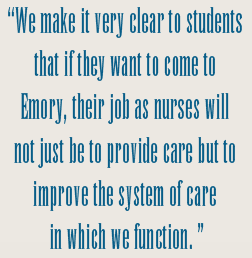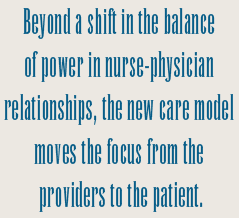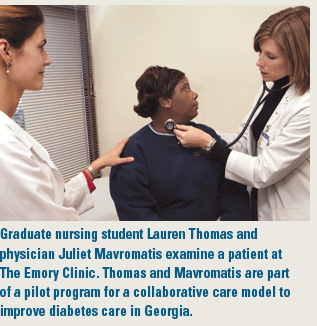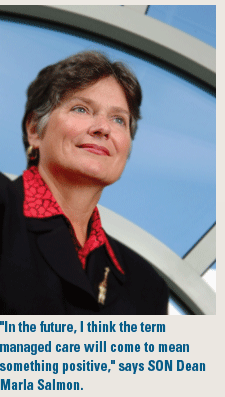














|
 |
| |
 |
|
 |
 f
you didn’t know better, you might think Marla Salmon runs
a business school. She talks about the future in terms of “systems
of partnerships,” and of managers who use “technological
interfaces and virtual resources.” f
you didn’t know better, you might think Marla Salmon runs
a business school. She talks about the future in terms of “systems
of partnerships,” and of managers who use “technological
interfaces and virtual resources.”
But because she heads the nursing
school and the system she refers to is health care, you realize
that what she is really saying is, in the coming years, people largely
will be in charge of their own health. And the partners and managers
needed to help them do this will be nurses.
Today’s stressed model of acute
health care—replete with high costs, inadequate care for many,
nursing shortages, and changing demographics—will need to
be replaced by managed, preventive, and coordinated care, she believes.
Nurses will increasingly move from their often supportive roles
to serving as care leaders in this new model. And with luck and
good planning, a large portion of the care for chronic or acute
illnesses now provided in expensive hospitals will shift to proactive
health management practiced within communities and families.
“I think in the future, managed
care will come to mean something positive and describe a situation
in which care management rests more on the patient, with the nurse
as coach,” says Salmon.
The concept is easiest to see in the
distant future, when a person’s own genetic barcode will reveal
early on which diseases he or she might be most susceptible to.
Nurses, who have long seen their role as educator, will serve as
a focal point for connecting medical science with the health experience of individuals and families. Nurses will serve as guides,
coaches, advocates, and resource experts, enabling people to take
a more active role in managing their own health and health care.
“We will be health partners who help people define and act
to reach their best health,” Salmon says, adding with a laugh,
“I see this as a bit like developing a financial plan for
money management.”
experience of individuals and families. Nurses will serve as guides,
coaches, advocates, and resource experts, enabling people to take
a more active role in managing their own health and health care.
“We will be health partners who help people define and act
to reach their best health,” Salmon says, adding with a laugh,
“I see this as a bit like developing a financial plan for
money management.”
Like a broker putting dollars into
investment accounts where they will best perform, the nurse of the
future will be the “interface” between patients and
resources that include physicians, specialists, diagnosticians,
advanced technology, and mountains of e-health information. “Nurses
will help personalize all those choices, both from the standpoint
of determining what the individual wants and needs and then making
sure it actually works for the person,” she says.
Nurses will also be responsible for
helping family members learn to care for ill loved ones.
“The care team has to become
everybody, not just those who are trained to be care providers,”
Salmon says.
“Say I have a diabetic child,
a mother with Alzheimer’s disease, and I have high blood pressure
and am pregnant,” she says. Currently, health care for such
a family would consist of numerous visits to both primary care physicians
and specialists for this particular condition or that. In the future,
however, a nurse would provide “more of a global overview
of my family’s health.
“There would be someone
that I could talk to about what I have learned about all this. And
someone who could say to me, ‘Let’s talk about your
family’s health—the things you are dealing with,’”
Salmon says. “We would work together on a family program to
help guide my decisions and give me all the information I need.
For example, with respect to my mother’s Alzheimer’s
disease, a nurse would help my family and me understand each stage
of her disease, what we should expect, and what we will need to
cope with it. She would outline how she could help.”
“The nurses of the future will
be what they have always been—the educator—but they
will also be the integrator, the guide, the coach, and the advocate
of patients and their families,” says Salmon.
Nurses will also assume leadership
roles in hospitals and in the myriad of other businesses and organizations
that surround the health care Goliath—insurance companies,
the biomedical industry, and government health policy makers, she
says. |
 |
| |
 |
|
 |
|
 |
| |
 |
|
 |
Who's
the boss? |
|
 |
Fundamental
to realizing this future role of nursing is the education that
takes place today. At the Nell Hodgson Woodruff School of Nursing,
Salmon says, the goal has been to educate cutting-edge partners
in patient care as well as research. “We make it very clear
to our students that if they want to come to Emory, their job
as nurses will be not to just provide care but also to improve
the system of care in which we function.”
“We have a strong focus on
critical thinking and skills to help nurses be lifelong learners
and leaders,” she says. “Many of our students come
with liberal arts and humanities backgrounds, which help them
understand nursing in the context of the larger world and how
they as nurses can be relevant in that world.”
Faculty also practice what they
teach. Kathy Matthews, instructor in the Department of Family
and Community Nursing, is collaborating with Richard Gitomer,
assistant professor in the School of Medicine and medical director of primary
care at Emory Crawford Long Hospital, on a project to improve
care for the chronically ill. They have been funded by the Robert
Wood Johnson Foundation to participate in a national program to
create a new model for managing chronic conditions, starting in
the academic setting. Matthews’ and Gitomer’s pilot
program is for patients with diabetes and mirrors the team approach
that Salmon describes.
professor in the School of Medicine and medical director of primary
care at Emory Crawford Long Hospital, on a project to improve
care for the chronically ill. They have been funded by the Robert
Wood Johnson Foundation to participate in a national program to
create a new model for managing chronic conditions, starting in
the academic setting. Matthews’ and Gitomer’s pilot
program is for patients with diabetes and mirrors the team approach
that Salmon describes.
“In our current system of
care, a patient usually sees a physician and the physician refers
the patient to a specialist to treat a specific problem,”
says Matthews. “It is a system of being farmed out, a system
that right now is geared to people with acute problems, not to
patients with chronic problems who need answers to questions that
arise between appointments.
“In this program, patients
with chronic health problems enter into lifelong learning about
their illness—a process that is not addressed in acute care,”
she says. “If you don’t talk to people about the kind
of journey they are taking, people revert automatically to the
acute care model, and they don’t have as much of a chance
to take control of their health care.
“They then become controlled
by the disease itself,” Matthews says. “You see that
a lot. The system provides neither the time nor the structure
for learning to occur, and we aim to correct that.”
To address such issues, Matthews
and Gitomer have convened a diabetes health team. All patient
records are available electronically and monitored regularly by
team members, who hold regular group discussions with patients.
The nurse practitioner is on a level playing field with other
health professionals to work with patients on lifestyle issues
and collaborate as needed with physician team members to address
the technical aspects of diabetes treatment. And Matthews points
out, “In fact, it may be the nurse, or even the patient,
who decides when to consult with a physician or another member
of the care team.”
The care model is based on the concept
of a “proactive, prepared team” of health care providers
who work to empower patients, explains Gitomer.
“One of the goals in developing
the team is to have all members function to the highest level
of their training or licensure,” he says. “There is
an emphasis on capitalizing on each member’s strengths,
rather than the hierarchical relationship that exists in many
health care settings.” |
 |
 |

 |
 |
 |

 |
 |
| |
 |
|
 |
'No
one is God in this system anymore' |
|
 |
Graduate
nursing student Lauren Thomas is already working in this new care
model. Enrolled in the school’s women’s health/adult
nurse practitioner program, Thomas is working in the clinic setting
with Gitomer and another physician, Juliet Mavromatis, caring for
patients with diabetes.
“Typically, I see the patients
before Dr. Gitomer or Dr. Mavromatis, and then we collaborate to
provide care,” Thomas explains. “In addition to the
initial examination, the patients complete a self-assessment form
that helps them take ownership of their disease and make decisions
along with their care providers. Many of the patients we see have hypertension
and hyperlipidemia, along with the diabetes, and all of these conditions
require continuous monitoring.”
with their care providers. Many of the patients we see have hypertension
and hyperlipidemia, along with the diabetes, and all of these conditions
require continuous monitoring.”
Beyond a shift in the balance of power
in nurse-physician relationships, the care model moves the focus
from the providers to the patient, says Gitomer.
“The traditional model was that
the source of the care comes from the providers who manage the care,”
he says. “This model is designed to place the patient at the
center. The care team facilitates the patient caring for himself
or herself to the highest level of ability.”
In that regard, Salmon points out
that the traditional relationship between nurses and physicians
in medical care has changed in recent years. “I don’t
think anybody is God in this system anymore,” she says. “My
view is that physicians and nurses are in many ways sharing a common
ground—a commitment to the well-being of patients, families,
and communities, and addressing concerns about quality and safety
that the rest of the health care system is struggling to even keep
in view.”
Maureen Kelley, chair of the Department
of Family and Community Nursing, is already demonstrating how a
collaborative team approach to prenatal care can have dramatic results
and redefine the experience for those involved. In this program,
“Centering Pregnancy,” a group of expectant parents
meet 10 times after the first three months of pregnancy. Instead
of the usual 15-minute visit to a provider once a month (in which
nurses play a supporting role), prenatal care, education, and support
are rolled together in this setting.
At Emory Crawford Long and Grady hospitals,
Emory nurse-midwives lead two-hour sessions in which the women first
complete a self-assessment, which includes checking their own blood
pressure and weight and recording fetal heartbeat. Then everyone
participates in a general discussion of issues of importance to
their health and future family life. “It empowers nurses because
it allows us to offer both in-depth education and care in the same
space—we function as coaches in a process that fundamentally
belongs to the pregnant couple and family. And it empowers parents
as well, because they are interacting and sharing knowledge with
each other,” Kelley says.
Studies of similar initiatives nationwide
have shown that mothers who participate in group-centered prenatal
care have lower rates of complications, use of drugs, and other
medical interventions and report higher rates of satisfaction with
the experience.
Kelley and Salmon see the program
as a model on which to base preventive health care in the society
at large. “We are a country in which the biggest health issues
are those that are often based on behavior, such as the choices
we make to smoke or exercise,” Kelley says. “With their
passion for education, nurses are ideally suited to impact the health
of the country at a place where it is most important, and that is
in the home and community.”
Renee
Twombly is a freelancer writer. |
 |
| |
 |
|
| |
|
|
|
|





